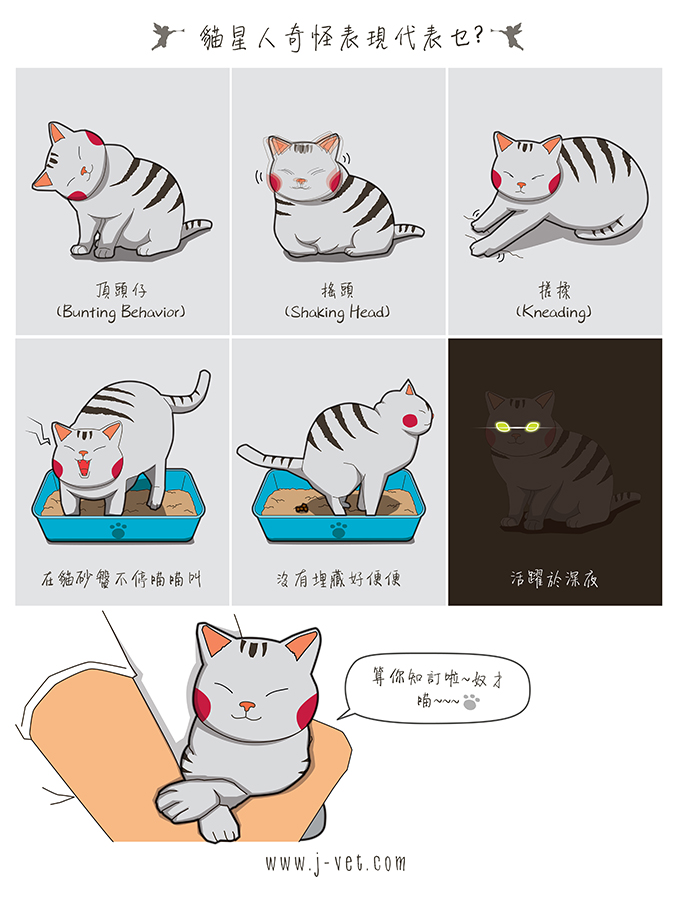寵物小知識
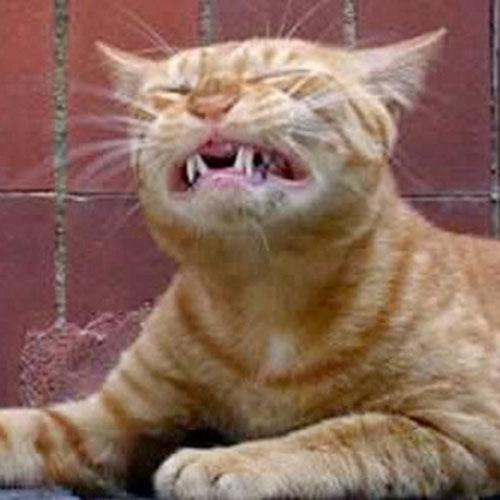
幼貓和老貓常見的呼吸系統疾病,通常是經病毒感染,較常見的病原體是貓皰疹病毒(Feline Herpesvirus 1– FHV-1 )或杯狀病毒( Feline Calicivirus – FCV )。貓呼吸道病毒容易傳染﹐會積聚在結膜、眼角膜、口腔和鼻腔等地方,潛伏後會在貓抵抗力下降、轉季、受壓時發病,症狀包括體溫上升、打噴嚏、咳嗽、流鼻涕、眼睛紅腫、眨眼頻繁、眼有膿狀分泌物。如感染了貓杯狀病毒,症狀也包括口腔潰瘍。其他較少機會感染的致病細菌包括衣原體( Chlamydophila Felis )和支氣管波氏桿菌( Bordetella Bronchiseptica )
貓呼吸病毒可經直接接觸及空氣傳播。受感染貓隻的眼分泌物和鼻分泌物帶有大量病毒,很容易經咳嗽、打噴嚏等將病毒傳播到附近的貓隻。從感染病毒恢復過來的貓,大多數會成為帶有病毒的貓及沒有任何病徵,沒有接種疫苗的貓直接接觸到帶有病毒的貓可被傳染到貓呼吸病毒。
確診貓呼吸道病毒需要眼分泌物和鼻分泌物送到化驗所化驗若,但獸醫一般跟據病徵和病曆作初步診斷。獸醫會使用高營養飲食,搭配離胺酸(Lysine)、抗生素眼藥水和多西環素(Doxycycline)等抗生素以預防上呼吸道的二次細菌感染。如程況嚴重,有可能需要使用口服抗病毒藥物如Interferon或Famciclovir和抗病毒眼藥水如Idoxuridine或Cidofovir。
由於貓呼吸道病毒十分普遍,流浪貓很有可能是帶有病毒或受感染,領養流浪貓時應檢查清查是否帶有該病毒或已接種疫苗,以免感染其他貓隻。如果家飼養了很多的貓或戶外飼養的貓,建議每年為貓貓接種疫苗。如果發現你的貓有上呼吸道疾病的病徵,記得把牠帶到獸醫診所作身體檢查。
貓貓有任何徵狀? 即時向獸醫查詢
寵物小知識
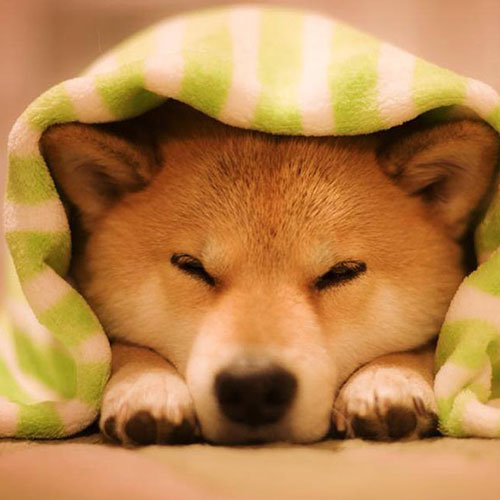
幼犬常見的呼吸系統疾病,較常見的有狗房咳和狗瘟
狗房咳 ( Kennel Cough )
狗房咳正如人類感冒,可能由許多不同的病毒引起的,狗房咳本身可以有多種病原體引致,其中最常見的罪魁禍首的是稱為支氣管炎博德特氏菌(Bordetella Bronchiseptica),其他病原體包括副流感病毒 ( Parainfluenza Virus) 和腺病毒(Adenovirus)。
呼吸道通常有粘液層,可以截取致病的微粒,但有一些原因令這些保護減弱,當狗隻吸入病原體,便容易感染狗房咳,導致喉嚨和氣管發炎。
這些因素包括:
- 置身於擁擠和/或通風不良的情況下,如在犬舍
- 寒冷氣溫
- 接觸粉塵或煙霧
- 長途運送引起的壓力
狗房咳的症狀
狗房咳的典型症狀是持續咳嗽。乾咳聽起來有點像鵝的叫聲。一般狗隻的食慾維持正常,有些患有狗房咳的狗隻可能會有其他症狀,包括打噴嚏、流鼻涕、眼部分泌物等。持續的狗房咳可導致肺炎,症狀包括呼吸急促、食慾不振。
狗房咳的治療
一般狗房咳大多數情況下需要抗生素和止咳藥,藥物能促進恢復或舒緩症狀。大多數患上狗房咳的狗在三個星期內會完全康復,一些老年或有其他疾病的狗可能需要長達六週的時間才康復。
狗房咳的預防
狗房咳的疫苗有三種形式:注射式、鼻噴霧式和口服式。獸醫一般會建議鼻噴霧式疫苗作第一次接種,隨後每年可用注射式的疫苗。狗房咳是會傳染的。如果你認為你的狗可能受感染,應該讓遠離其他動物,並聯絡獸醫。
狗瘟 (Canine Distemper)
狗瘟是影響狗的呼吸道、消化道和中樞神經系統的致命疾病。狗瘟病毒(Canine Distemper Virus)最初會複製到呼吸道的淋巴組織,其後沿着淋巴組織感染消化系統和中樞神經系統。狗隻的免疫系統減弱導致二次感染如腸胃炎、肺炎及腦炎,最終死亡。該病毒透過尿液、血液或唾液直接接觸傳染。打噴嚏、咳嗽都可能傳播病毒。沒有接種過疫苗的年幼及年老狗隻最容易狗瘟病毒。
狗瘟的症狀
症狀包括打噴嚏、咳嗽、眼水和鼻水。當病毒攻擊消化系統時,狗隻便會發燒、嘔吐、腹瀉和食慾不振。當病毒感染到中樞神經系統,狗隻便會癲癇和昏迷。
狗瘟的診斷
一般獸醫診所備有狗隻病毒快速測試(ELISA)作初步診斷用途。較準確的測試需要狗隻的血液,並送到化驗所進行逆錄聚合酶鏈式反應測試(Reverse transcription polymerase chain reaction)。
狗瘟的治療
現時沒有藥物可有效消滅狗瘟病毒。獸醫一般會將患上狗瘟病的狗隻留院及隔離,同時安排支援性治療、靜脈藥物注射和抗生素以防止二次感染。留院期間,狗隻的病情可能反覆不定,最終甚至惡化,嚴重可致死亡。即使從狗瘟中康復,亦有可能會有癲癇、永久腦損傷或其他中樞神經系統疾病的後遺症。
狗瘟的預防
狗隻一般需要在六到八週大的時候接種第一次疫苗。隨後每月一次直至完成三次疫苗接種後,身體才有足夠的免疫力抵抗狗瘟病。狗隻也需要每年接種疫苗以維持免疫力。
建議
如果發現你的狗隻有呼吸道病的癥狀,如咳嗽、打噴嚏,請聯絡獸醫,若果狗隻的疫苗接種已過期,請儘速安排到獸醫診所接受疫苗注射。
狗狗有任何徵狀? 即時向獸醫查詢
寵物小知識
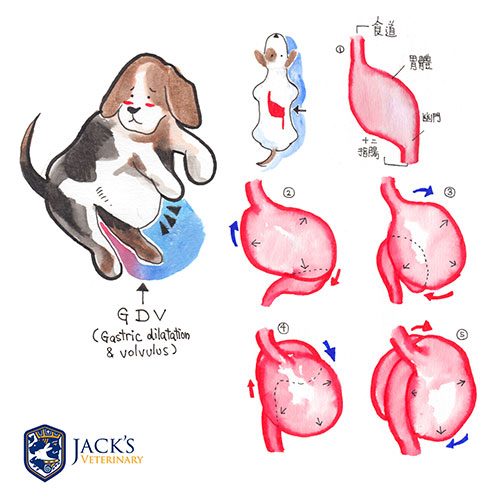
What is GDV?
GDV ( Gastric Dilatation & Volvulus ) is a critical emergent medical case of a severe dilation and torsion of the stomach in a dog. It usually happens on large breed and deep chest dogs but could sometimes happen on small breed dogs. Dogs usually develop to GDV within couple of hours. The chance of survival is zero if it is not treated immediately.
Pathophysiology of GDV
Initially, the fundus of the stomach starts distending. The muscle layer of pylorus is thicker and stiffer so it is less distensible compared to the fundus; therefore, the pylorus will be pushed away by the distended fundus. The more the dog gets nervous and pants due to the discomfort and pain, the more the gas enters into the stomach. When the fundus is continuing to distend, the fundus will give a push to the pylorus downward at the right side of the abdominal cavity; therefore, the pylorus will go around the bottom of the fundus and reach to the bottom left of the abdominal cavity. When the fundus is further distended, the pylorus has no way to go but is squeezed upward to the top left. At this position, the duodenum meets and crosses around the esophagus. This configuration traps all the gas and ingesta into the stomach, and the gas and ingesta are neither passed down to the small intestines nor vomited out. The aorta and vein are compressed causing a poor circulation. The lesser the blood supply to the stomach, the higher the chance it gets necrosis. Splenic torsion or rupture may occur concurrently when the fundus of the stomach distended sufficiently. Haemorrhage from the gastric and splenic vessels is very common due to the strong traction force produced by the fundus distension and torsion. Over a short period, the patient will die in hypovolemia and hypoxemia due to the poor circulation and insufficient cardiac output.
Cause of GDV
The cause of GDV is unknown. The risk of GDV seems related to the thoracic confirmation. The deeper thorax is more likely to experience GDV. There is still debating what predisposes dogs to GDV. However, any issue that causes abnormal gastric motility such as gastric foreign body and mass may predispose to GDV.
(** My personal opinion: the abdominal wall angle predisposes to GDV in large breed dogs and deep chested dogs. The angle of abdominal wall of deep chest dogs is higher of which pylorus will be pushed from right to left and forward when the fundus is distended. When the fundus is further distended, the pylorus will be left up on the left side. )
Symptoms of GDV
Initially, dogs with GDV will have frequent vomiting over a short period. Some dogs may develop unproductive retching and salivation. Panting follows and abdominal starts to distend. Later, the abdomen is distended and noticeable. Panting and unproductive retching continue. Finally, the dogs will collapse or be in coma and die.
There are many complications of GDV including endotoxiemia, septic shock, haemorrahge, splenic rupture, intestinal necrosis and stomach necrosis etc.
Diagnosis of GDV
Radiograph of abdominal cavity can be used to confirm the stomach distension and torsion. Blood tests are usually performed to obtain information for anaesthesia and initial therapy.
Treatment of GDV
There is no chance for a dog to recover from GDV on itself. This is always an emergent case, and requires surgery to treat it.
Veterinarians will perform a set of emergency procedures including an aggressive high rate intravenous fluid therapy and decompression of the stomach to try to stabilize the dog as much as possible. The aggressive intravenous fluid can expand the blood volume and aid better circulation. Decompression of stomach will relieve the pressure of the stomach thus aid the circulation. Other treatments include antibiotics and analgesia. When blood pressure increases to a better level, anaesthesia and surgery are able to start. Veterinary Surgeon will decompress the stomach and reposition the stomach. Control the bleeding and remove any necrotic parts of the stomach or intestines. Sometimes the spleen will be removed if the splenic vessels are severely damaged. At the end, veterinary surgeon will suture the pylorus of the stomach to the right side of the abdominal wall to prevent recurrence of GDV.
Advice
Calm down and call up your veterinarian immediately when you suspect your dog has GDV!
寵物小知識
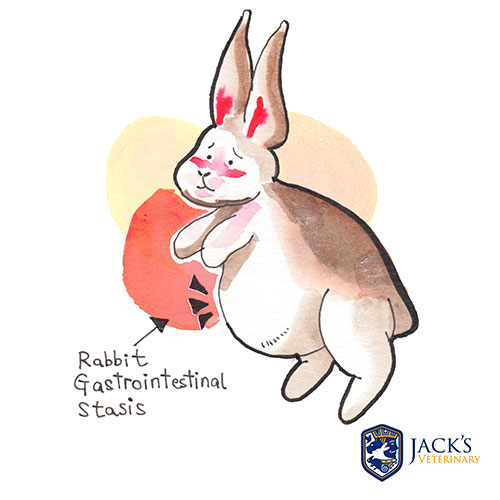
I believe that most of the rabbit owners agree that the most common disease in rabbit is gastrointestinal stasis ( GI stasis ). Many owners found their rabbit suddenly ate less and looked dull inside the cage. Some rabbits may stop eating within few hours. Eating less is a signal of life-threatening disease, and this worries owners a lot.
Rabbits are hindgut fermenters and their GI peristalsis requires a lot of fiber and fluid to stimulate to work; therefore, they spend most of their time on eating. Stress or anxiety gives rabbits stress. This stress can cause rabbits to eat less; therefore, their peristalsis slows down and may stop eventually when it gets worse. Their intestines have many yeasts and gut floras for fermentation thus they produce lots of gas. Because rabbits physiologically have no mechanism of vomiting, large amount of gas developed and trapped into the GI tract when peristalsis stops. When their stomach is distended to a huge large size, the aorta and vein will be compressed thus the blood circulation will become poor, resulting in shock, even collapse and death.
Where does a rabbit get stress from? There are many reasons and usually being grouped into 3 categories. All of the reasons below can cause rabbits stress enough to develop GI stasis.
1) Environmental & dietary: noise ( neighbor construction, party ), sudden weather change, sudden diet change, new pets at home, new home, low fiber diet etc.
2) Pain: dental disease, tooth root abscess, osteoarthritis, sore hocks, bladder stones etc.
3) Systemic disease: any severe disease such as severe inflammation, kidney disease, trichobezoar ( hair ball obstructed at the intestines ) etc.
There are 3 grades of rabbit GI stasis according the symptoms and severity of the disease.
Grade 1: slightly reduce of appetite, small size or reduce amount of stool.
Grade 2A: moderate reduce of appetite, small size and/or moderate reduced amount of stool. Mild to moderate stomach distension
Grade 2B: No appetite and stool. Mild to moderate dehydration. Mild to moderate stomach distension.
Grade 3: No appetite and stool. Severe dehydration. Severe stomach distension or impaction.
Veterinarians need to take a long medical history and perform a physical examination on the rabbit. Blood test and radiography are usually recommended to obtain the body condition information such as dehydration status and possible underlying primary cause of the disease.
Each grade of GI stasis requires different medical approach. Grade 2b and 3 are always critical and hospitalization is recommended.
Many rabbit owners mistreat their rabbits at home resulting in death. The most common mistake is feeding GI pro-kinetic which drug is used for a rabbit with GI impaction or obstruction resulting in death quickly at home. Therefore, you should always contact your veterinarian when you notice your rabbit starting to eat less.
Avoiding low fiber diet and pellet is the first step of preventing GI stasis. High fiber can prolong the chewing time thus the best method to prevent dental malocclusion, stress and pain related to GI stasis. Be aware of environmental factors listed above. Comb their hair more frequently when their coat changes seasonally to avoid hair ball obstruction. Regular body check of your rabbit by a veterinarian is the best recommendation of preventing GI stasis.
寵物小知識
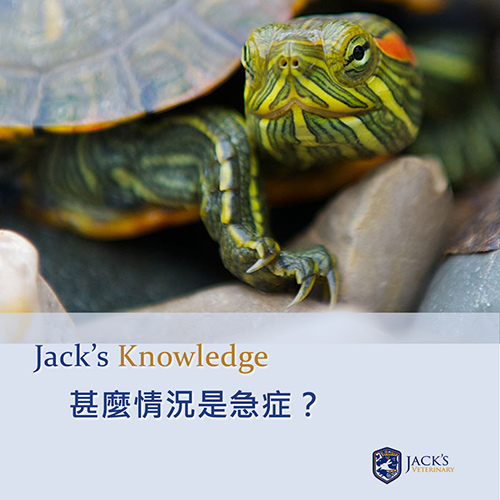
Jack’s Vet 上星期晚收到一個關於雌性紅耳龜(巴西龜)的緊急諮詢。
當時,主人預約了兩日後到普通科門診,而不被視為急症門診。我們的獸醫留意到情況非常嚴重,所以立刻回覆。我們希望多些人可以知道這些症狀的嚴重性。
當龜有不明的部份器官組織從尾部泄殖腔位置跌出,這樣大多數都是嚴重的情況。
當跌出的部份自行縮回體內,很多人,包括獸醫護士都會建議「先繼續監察」。但是,縱使已不再突出或突出不再明顯,仍然有機會是急症。如何判斷,是建基於很多不同原因,而性別的不同也是需要注意的因素。
雌性水龜生蛋時有機會出現「塞蛋」的現象,從而導致輸卵管脫垂(Ovarian Ductal Prolapse)、泄殖腔脫垂(Cloacal Prolapse)或直腸脫垂(Rectal Prolapse)。雖然有時候跌出的部份會自行縮回,但情況仍然是十分嚴重,需要即時找獸醫診斷。
只有有經驗的獸醫人員能察覺這情況的嚴重程度,以及時診症。即時的專業判斷可以挽救到一條生命。
龜龜有任何徵狀? 即時向獸醫查詢
寵物小知識
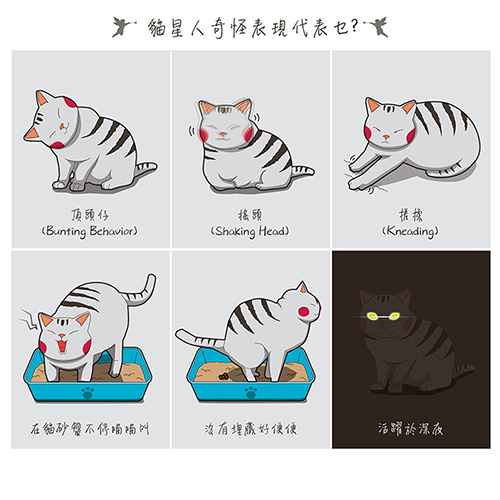
The Meaning Behinds Your Cat’s Strange Behaviors
Cats have distinct personalities and we often find ourselves confused with some of their weird behaviors.
Many cat owners know the rewarding sound of a purr and the loud meow of a hungry cat. It is always the unusual nature of certain vocalizations or actions that make us want to know more about their thinking or feeling.
To be a good cat salves, it is time to read and learn more about the most common strange cat behaviors and their underlying reasons:
Head rubbing
Cats will rub their heads on certain household objects, on their owner’s legs and even on other pets.
This behavior is associated with greeting or someone they are comfortable with, and sharing their pheromones. This is called to as bunting behavior.
Shaking Head
When you observe your cat shaking his head, scratching his head or ears, or walking imbalance, this could indicate an underlying medical problem.
This behavior can often be attributed to an ear infection and inflammation, which should be evaluated and treated by veterinarian. On the other hand, your cat may have an ear polyp, which is a non-cancerous growth originating from the middle ear that are diagnosed by examination of the ear canal and can be removed surgically by veterinarian.
Kneading
Many cats will use their paws to knead a blanket, soft object or bed rhythmically. This indicates that they are happy and leave their scent or alleviate anxious feelings.
This is an instinctual behavior that cats have retained from their days as kittens, when they would use their paws to stimulate milk letdown from their mothers.
Excessive meowing in the litter box
There are several reasons for this abnormal behavior.
One serious concern would be a urinary tract obstruction, which is very painful and considered a veterinary medical emergency. If you observes your cat frequently spending time in the litter tray, but only producing small amounts of urine or even vocalizing, seek out veterinary care immediately.
A urinary tract infection, inflammation and constipation can also cause your cat to display similar clinical symptoms.
Uncovered feces
Cleaning your cat’s litter tray is a daily ritual for most of cat salves which indirectly helps us become accustomed to our cat’s particular habits.
When our cats suddenly decides to defecate and leave the fecal matter uncovered, we tend to feel something is wrong. This behavior often indicates marking territory or establishing dominance in a household. The uncovered fecal matter may also be your cat’s way of telling you that the litter tray is either too small or too dirty.
You should also be aware of any injuries in your cat’s paw or legs that could be preventing them from covering their fecal matter properly.
Late night activity
Another strange behavior may be observed by cat owners is late night hyperactivity. This could be related to a change in your cat’s sleep schedule resulting in playtime during late night hours. Bored cats will also look for ways entertain themselves, even while you are sleeping during the night time. Providing your cat with interactive and toys can help alleviate this boredom and behavior.
Other reasons for hyperactivity at night could be due to a disease called, hyperthyroidism, which can make your cat feel restless and ravenously hungry. When you suspect your cat may be suffering this disorder, please consult with veterinarian for diagnosis and treatment.
Final thoughts
Establishing a close relationship with your cats can help you better understand their particular needs. Regardless of how well you know your cats, there will be sometimes when your cats will act in ways that will make you shake your head.
You should always rule out a medical issue with veterinarian before considering any behavioral issues.
Finally, you should keep tracking of any recurring behaviors that might finally help you understand your favorite cat’s mood and state of mind.
